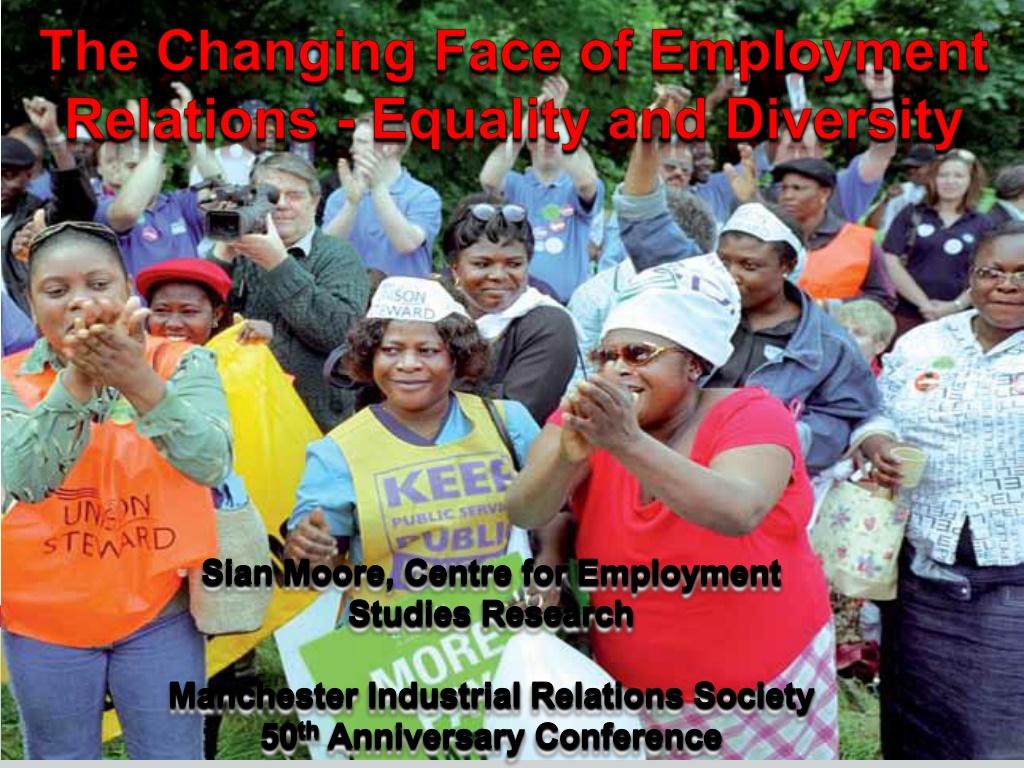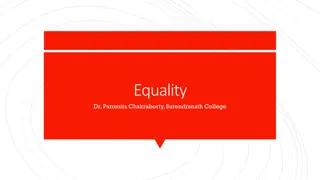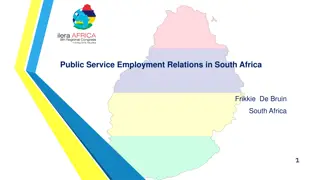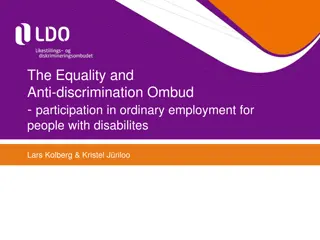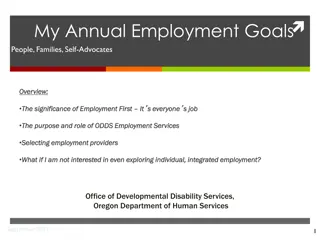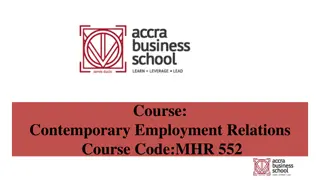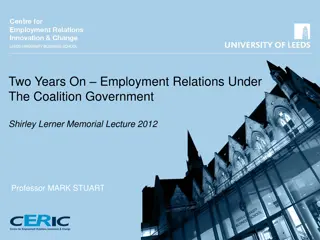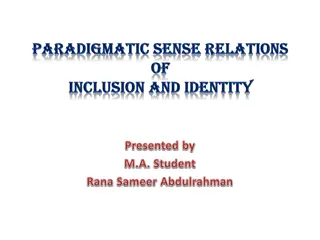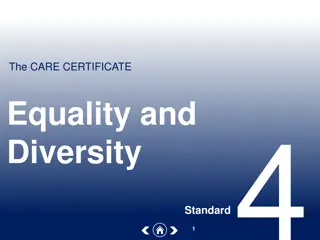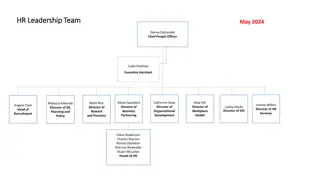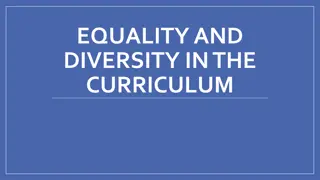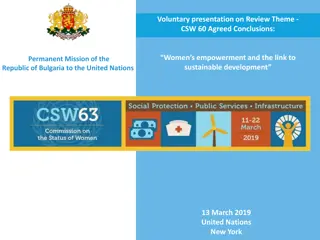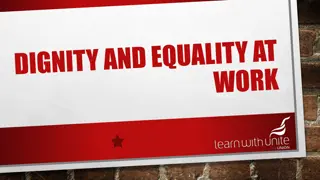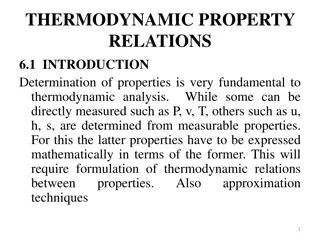The Changing Face of Employment Relations: Equality and Diversity Over 50 Years
Examining the evolution of employment relations in the past 50 years, focusing on responses to discrimination, liberal and radical models of equality, voluntary and legal routes, gender pay gaps, and the impact on different demographics like women and young workers. The analysis also addresses the growing income disparities and implications of neoliberal capitalism.
Download Presentation

Please find below an Image/Link to download the presentation.
The content on the website is provided AS IS for your information and personal use only. It may not be sold, licensed, or shared on other websites without obtaining consent from the author. Download presentation by click this link. If you encounter any issues during the download, it is possible that the publisher has removed the file from their server.
E N D
Presentation Transcript
The Changing Face of Employment Relations - Equality and Diversity Sian Moore, Centre for Employment Studies Research Manchester Industrial Relations Society 50thAnniversary Conference
The Changing Face of Employment Relations Equality and Diversity The responses to discrimination as vehicles for equality over the past 50 years; tension between voluntary and legal The shifting relationship between liberal and radical models of equality; Self-organisation response? as the radical political Intersectionality a liberal or radical response?
The Changing Face of Employment Relations Equality and Diversity The voluntary route Collective Bargaining, the Living Wage; The legal route Equal Pay; the Equality Act; The Recognition; the NMW; statutory route Statutory union The equality reps. workplace self-organisation and/or
The Changing Face of Employment Relations Approaching 50 years since the women sewing machinists at Ford's Dagenham went on strike over equal pay where are we? Neo-liberal capitalism and yawning wealth and income gaps on the vertical plane alongside extant social divisions and inequalities; The growth in executive pay means that whilst in 1979 the top 10% took home 28% of the national income, by 2007 this had grown to 40%. (High Pay Commission, 2012).
The Changing Face of Employment Relations Equality and Diversity Overall gender pay gap 2014 was 19.1%, full- time gender pay gap 9.4% (median gross hourly earnings) back to 2012 gap; Increase in public sector from 9.5% to 11% (private sector decreased from 19.2% to 17.5%); Part-time women earn 5.15 per hour less than full-time men 38%.
The Changing Face of Employment Relations Equality and Diversity Women, young and older workers at most risk of low pay; 22% of all workers low paid; 27% women, but proportion of low paid men has increased; 81% of those aged 16-20 and 40% 21-25; 33% aged 66 and over. Resolution Foundation, 2013
The Changing Face of Employment Relations Equality and Diversity Austerity - more than 820,000 more women have moved into low paid, insecure jobs since the start of the recession in 2008 (Fawcett Society). Ethnic pay gap occupational segregation and class (Brynin & Guveli, 2012); The ethnic pay gap largely disappears for women employed part-time dominates (Metcalf, 2009); the gender pay gap Intersections of class, gender, age and ethnicity.
Collective organisation In the UK women are currently 55% of aggregate union membership (BIS 2014), although the total has halved since the end of the 1970s. Black British workers are more likely to be union members than all employees (29% compared to 26% in 2013) and this is particularly true for black women.
What happened? The voluntary route - Collective Bargaining Historically sectoral and exclusive; But potential for a wider basis of collective bargaining; Flexibility, enforcement and voice (Dickens, 2000). acceptability, legitimacy,
Collective Bargaining harnessing collective bargaining as a mechanism for the promotion of gender equality implies radical change in the traditional platforms and approaches of much collective bargaining and poses challenges to the existing nature (Dickens, 2000). of many trade unions Unions reconfigure internal structures; Self-organisation women workers. of black, disabled, LGBT and
Collective Bargaining Retreat from Fordism and corrosion of national, sectoral and enterprise bargaining removal of state support; Collective bargaining covered 71% of workforce in late 1970s, Wages Councils set minimum pay rates for a further 11% (statutory); 2012 29% of the workforce covered, 16% in the private sector (LFS, 2012); Proportion of workers falling below low pay threshold rose from a low of 15% in 1975 to a peak of 23% in 1996.
Responses to decline Statutory Recognition Limited scope of statutory agreements extended to voluntary pay, hours and holidays; Equal opportunities specified as a subject of bargaining in less than one in ten (8%) and specifically excluded in one third (31%) (Moore et al. 2004) a procedural issue; Fewer than one in ten (7%) agreements provided for collective bargaining policies; on family-friendly Boots Pharmacists.
The fragmentation of bargaining transformational governance in the public sector (Colling) privatisation, diversification of provision; outsourcing, Removal of workers from direct employment, collective bargaining representational structures, representation and organisation; coverage, existing Contract based recognition social care.
The fragmentation of bargaining Equal Pay (ASDA); Concentration workers geographical areas (Wills et al., 2010) suggests strengthened divisions of labour on the basis of race, gender and ethnicity. of privatised women, black services and migrant some in in
Responses to decline the NMW Introduction of NMW from 1999 to improve pay at the bottom of the wage structure (Grimshaw and Rubery, 2010); Reduction of those on extreme low pay falls from one third in 1997 to 2% in 2012 (Whittaker and Hurrell, 2013); LPC reports that hourly median gender pay gap nearly halved from 15.9% in 1998 to 9.4% in 2013 (5.8% at bottom and 20.5% at top).
LPC - Hourly Pay Gaps for Particular Groups of Workers Aged 22 + (LFS) Per cent 2007/8 2008/9 2009/10 2010/11 2011/12 2012/13 No qualificatio ns 34.4 35.3 34.9 34.6 34.3 33.7 Women 19.5 19.5 17.6 19.1 17.4 18.6 Disabled 11.1 11.7 9.9 9.5 8.9 9.1 Migrant workers 3.9 5.5 8.2 7.8 6.1 7.2 Ethnic Minorities 3.9 5.3 5.0 3.4 4.0 3.6
Responses to decline the NMW Increases in the minimum wage led to small reduction in hours and weeks worked (Gregg & Papps 2014); CBI lobbying from 2006 for realignment with average earnings growth; and economic crisis real value of NMW falls; 45% of NMW workers work 20 hours or fewer a week - around 56 per cent of NMW workers received a cut in real take-home pay in 2013/14; NMW as benchmark for hourly pay.
Equality Law Article 13 EC requires action to combat discrimination on six strands sex, racial and ethnic origin, disability, age, religion and sexual orientation; The discrimination bodies directed at specific groups; unification of separate policies anti- and legislation, A more integrated approach to equality multiple discrimination?
Responses to decline Equality Law The language of the Equality Bill echoes popular perceptions of equality, which focus on the idea of equal opportunities, or protection from discrimination , a fairness approach to equality (Squires); Equality Act 2010 public sector equality duty, statutory pay audits and multiple discrimination abandoned.
Responses to decline Equality Reps Refusal of Labour Government to grant statutory rights to Equality Reps; Over a quarter (28%) of unions had provision for the nomination or appointment of ERs in the workplace (TUC Equality Audit 2012); Individual representation with no collective bargaining role? (Daniels and McIlroy, 2009);
Responses to decline Equality Reps An abstract notion of equality as fairness - reflecting the prevailing legislative and policy trends rather than the single-strand focus of self-organisation; Reluctance to positively identify in terms of race, gender, class, sexuality, disability or age - a more inclusive approach to equality OR dilution? Tension then between the equal treatment/sameness conceptions driving ER role and radical or difference perspective underpinning self-organisation? Complementarity (generational)?
A return to voluntarismthe Living Wage Mobilisations beyond the workplace engaging so- called hard to organise migrants - largely independent of unions; workers, including 10,000 workers won a LW 2005-11 (Pennycock, 2012); 5.24 million earning below LW in 2013: 21% of all employees, 27% of women, 17% men (Pennycock- ASHE); Increase in proportion of jobs paying below LW because of the rise in living costs (KPMG, 2013).
A return to voluntarismthe Living Wage? Employers can accommodate the NMW and LW through the configuration of hours; Zero hours contracts unstable weekly income; Removal of unproductive time (episodic work); Increase in unpaid labour unpaid women s labour in the care sector driven by the commissioning process.
A return to voluntarism the Living Wage? Supercedes collective bargaining? Precludes bargaining over a range of other terms and conditions, including equality.
Collective Bargaining Women are more likely to be covered by collective bargaining (Emery, 2012) they predominate in health and education public services Benefit more than men from the squeezed, but persistent, union pay premium (Bryson and Forth, 2010; BIS 2014) Unions are constraining wage inequality (ibid).
Conclusions Decline associated with wage inequality (Brown & Marginson, 2001); in collective bargaining Return to sectoral collective bargaining as a key vehicle for equality (Ewing and Hendy, 2013)? But expansive and inclusive; Reinforces labour market segregation?
Conclusions Failure of the liberal model to deliver equality; Incorporation neoliberal programme (Fraser)? of feminism into the Huge expansion in women s employment part-time, low paid, insecure; The flexibility (homeworking). business case employer-driven
Conclusions Failure of voluntarism in the context of weakened unions; Hardening of occupational segregation and divisions of labour through privatisation; Austerity as a vehicle to push back gains of the past decades; Need outside the workplace? for self-organisation within and
